
Hardman & Co., otherwise John Hardman Trading Co., Ltd., founded 1838, began manufacturing stained glass in 1844 and became one of the world's leading manufacturers of stained glass and ecclesiastical fittings. The business closed in 2008. [1]

Hardman & Co., otherwise John Hardman Trading Co., Ltd., founded 1838, began manufacturing stained glass in 1844 and became one of the world's leading manufacturers of stained glass and ecclesiastical fittings. The business closed in 2008. [1]
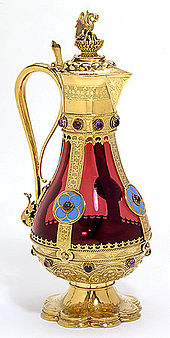
John Hardman senior, (1766–1844), of Handsworth, then in Staffordshire, England (and now part of Birmingham), was the head of a family business designing and manufacturing metalwork. He was described as the "opulent button maker and medallist". [3] In the 1830s Augustus Welby Pugin was commissioned by the Roman Catholic Bishop, Thomas Walsh, to design a suitable church to house the remains of St Chad, which had been rescued from destruction at Lichfield Cathedral during the Reformation. When the building was consecrated in 1841 as Saint Chad's Cathedral, it was the first Roman Catholic cathedral to be built in England since the Reformation. For the recently converted Catholic, Pugin, this was a commission of great importance.
Pugin first had contact with the John Hardmans during the construction of St Chad's Chapel, the forerunner to the cathedral scheme. John Hardman junior, (1812–67), left the family business in 1838 and set up on his own to manufacture ecclesiastical metalwork. Pugin employed Hardman's to provide metalwork for St Chad's Cathedral. Hardman was an enthusiastic donor, giving the rood screen to the cathedral and being recognised for his provision to various charities by the gift of the Hardman Chantry in which John Hardman senior was interred in 1844, and which remained the family burial place. [4]
From 1845, at the urging of Pugin, John Hardman entered the burgeoning industry of stained glass manufacture. He was joined by his nephew, John Hardman Powell (1827–95) who married Pugin's daughter Anne in 1850, and claimed to be Pugin's only pupil. Powell became the chief designer from about 1849, prior to Pugin's death in 1852. The company took part in the Great Exhibition of 1851 in London, exhibiting the great chandelier designed for Alton Towers.
Hardman and Powell collaborated with A. W. Pugin's son, E. W. Pugin, firstly in the design of the funeral arrangements of John Talbot, 16th Earl of Shrewsbury in November 1852. The collaboration between the Hardman firm and the Pugins was to continue after E. W. Pugin's death in 1875 with the later firm, Pugin & Pugin. This collaboration lasted for three generations and was a major influence on Catholic church architecture and decoration in particular and the Gothic Revival in general.
Under the management of J.H. Powell the metalwork design department split from the stained glass department in 1883 and traded under the name Hardman, Powell and Co. Powell died in 1895, passing the leadership of the firm to John Bernard Hardman, the grandson of John Hardman Snr, who headed the company until 1903 and took the firm to the Exposition Universelle, Paris. The firm continued producing stained glass in the 21st century under directorship of Donald Taunton and Patrick A. Feeny until the 1970s, and had premises at 26 Frederick Street in the Jewellery Quarter, Birmingham, Newhall Hill and Lightwoods House. A large proportion of the Hardman archive, particularly their Medieval Room, was damaged and destroyed in a fire at the Newhall Hill studio in 1970; some of the earliest and most damaged cartoons are now held in temperature controlled storage at Birmingham Museum and Art Gallery. Hardman acquired the stained glass manufacturer Goddard & Gibbs in 2006, but two years later, in 2008, the business closed. [5]

Through the influence of A.W.Pugin, John Ruskin, and the Oxford Movement, it was considered during the mid-19th century that the only appropriate style in which a church should be built was Gothic. This fashion was combined with a general renewal within the church and a growth of Roman Catholicism. The result was that many designers in different fields tried to imitate the Medieval style in their work. This was particularly the case in the stained glass industry.
Pugin, who supplied the first designs for Hardmans, was thoroughly absorbed in the Medieval and was a designer of the highest order. He produced designs of every description- churches, windows, furniture, vestments, vessels, tiles, jewellery and, for the interiors of the Houses of Parliament, Gothic thrones, Gothic hat-stands and Gothic ashtrays. With his busy regime, he increasingly relied upon his talented son-in-law, Powell, to provide the designs for stained glass.
The firm had many subcontractors and designers who are not well-known but produced exceptional work under the Hardman name. For example, the Pippet family of Solihull, William John Wainwright and R.J. Hopkins. [6]
Powell's stained glass recreates the elegance, the refinement, the brevity that is seen in some of the finest examples of glass, sculpture and illumination of the 13th and 14th centuries. He utilised the flowing, curving lines, the flourish of drapery, the calligraphic brushstrokes and pure colour. However, Powell's work was not, like many stained glass designers, merely imitative. His designs are original innovations in the Gothic style. The quality of Hardman's church windows, particularly in the 1850s and 1860s, was superb.
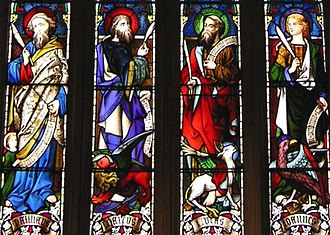
The most famous building that the Hardmans made glass for was the new Houses of Parliament in London, for which Pugin was the interior designer. Pugin employed the Scottish firm of Ballantine and Allen to manufacture the windows that he designed for the House of Lords, but all the rest were made by Hardmans, who have maintained their relationship with that building, repairing and replacing glass damaged or destroyed during World War II.
Apart from the windows created for Pugin's churches in England and Ireland, two of Hardman's major commissions were to come from Australia. In the 1860s the architect Edmund Blacket commissioned Hardmans to supply 27 windows, including a 6-light West window and a 7-light East window for St. Andrew's Cathedral, Sydney. They were installed for the consecration in 1868.
In the 1880s William Wardell selected the same firm to provide windows for St. Mary's R.C. Cathedral in the same city. This building, of which the nave was not completed until the 1930s, is very much larger than St Andrew's and has three large rose windows and an enormous East window, the tracery of which was based directly on that of Lincoln Cathedral, c.1280. The design of this huge window, depicting the Coronation of the Blessed Virgin Mary is one of the pinnacles of achievement in Gothic Revival stained glass.


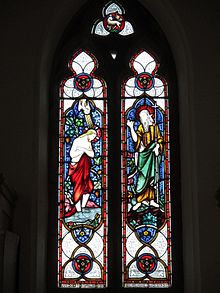

England
Brighton|St. Mary Magdalen's Church]], Brighton, East Sussex
Northern Ireland
Scotland
Australia
United States of America


Augustus Welby Northmore Pugin was an English architect, designer, artist and critic with French and Swiss origins. He is principally remembered for his pioneering role in the Gothic Revival style of architecture. His work culminated in designing the interior of the Palace of Westminster in Westminster, London, and its renowned clock tower, the Elizabeth Tower, which houses the bell known as Big Ben. Pugin designed many churches in England, and some in Ireland and Australia. He was the son of Auguste Pugin, and the father of Edward Welby Pugin and Peter Paul Pugin, who continued his architectural firm as Pugin & Pugin.
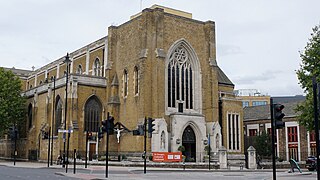
The Metropolitan Cathedral Church of St George, usually known as St George's Cathedral, Southwark, is the cathedral of the Roman Catholic Archdiocese of Southwark, south London, and is the seat of the Archbishop of Southwark.
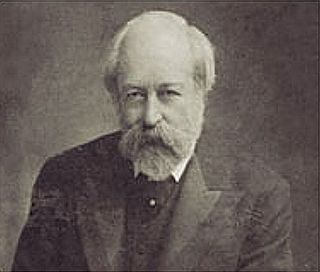
George Frederick Bodley was an English Gothic Revival architect. He was a pupil of Sir George Gilbert Scott, and worked in partnership with Thomas Garner for much of his career. He was one of the founders of Watts & Co.

The Metropolitan Cathedral Church and Basilica of Saint Chad is a Catholic cathedral in Birmingham, England. It is the mother church of the Archdiocese of Birmingham and is dedicated to Saint Chad of Mercia.

The Cathedral Church of St. John the Evangelist, usually known as Salford Cathedral, is a Catholic cathedral on Chapel Street in Salford, Greater Manchester, England. It is the seat of the Bishop of Salford and mother church of the Diocese of Salford, and is a Grade II* listed building.

Charles Eamer Kempe was a British Victorian era designer and manufacturer of stained glass. His studios produced over 4,000 windows and also designs for altars and altar frontals, furniture and furnishings, lychgates and memorials that helped to define a later nineteenth-century Anglican style. The list of English cathedrals containing examples of his work includes: Chester, Gloucester, Hereford, Lichfield, Wells, Winchester and York. Kempe's networks of patrons and influence stretched from the Royal Family and the Church of England hierarchy to the literary and artistic beau monde.

The Cathedral Church of Our Lady Help of Christians and Saint Peter of Alcantara, commonly known as Shrewsbury Cathedral, is a Roman Catholic cathedral in Shrewsbury, England. It is the seat of the Roman Catholic Bishop of Shrewsbury and mother church of the Diocese of Shrewsbury, which covers the historic counties of Shropshire and Cheshire.

The Cathedral Church of St Mary and St Thomas is a Roman Catholic cathedral in Northampton, England. It is the seat of the Bishop of Northampton and mother church of the Diocese of Northampton which covers the counties of Northamptonshire, Bedfordshire, Buckinghamshire and part of Berkshire north of the River Thames. The cathedral is situated in the north of the town, along the Barrack Road.

A revival of the art and craft of stained-glass window manufacture took place in early 19th-century Britain, beginning with an armorial window created by Thomas Willement in 1811–12. The revival led to stained-glass windows becoming such a common and popular form of coloured pictorial representation that many thousands of people, most of whom would never commission or purchase a painting, contributed to the commission and purchase of stained-glass windows for their parish church.

Thomas Willement was an English stained glass artist, called "the father of Victorian stained glass", active from 1811 to 1865.

William Warrington, (1796–1869), was an English maker of stained glass windows. His firm, operating from 1832 to 1875, was one of the earliest of the English Medieval revival and served clients such as Norwich and Peterborough Cathedrals. Warrington was a historian of medieval glass and published an illustrated book The History of Stained Glass.
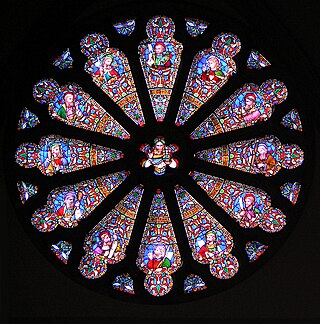
William Wailes (1808–1881) was the proprietor of one of England's largest and most prolific stained glass workshops.

Clayton and Bell was one of the most prolific and proficient British workshops of stained-glass windows during the latter half of the 19th century and early 20th century. The partners were John Richard Clayton (1827–1913) and Alfred Bell (1832–1895). The company was founded in 1855 and continued until 1993. Their windows are found throughout the United Kingdom, in the United States, Canada, Australia and New Zealand.

St. Laurence's Church, Northfield is a parish church in the Church of England in Northfield, Birmingham. The church is in a conservation area near nail maker's cottages, the Great Stone Inn, the old school and the Village Pound.

Nathaniel Hubert John WestlakeFSA (1833–1921) was a 19th-century British artist specialising in stained glass.
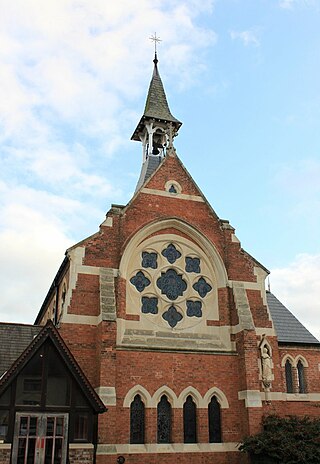
St Mary Immaculate is an active Roman Catholic parish church in the town of Warwick, England. It lies to the south west of the town on West Street outside the West Gate. The church was opened on 12 May 1860. The architect was Edward Welby Pugin, eldest son of Augustus Pugin. The church is built in red brick and Bath stone in the Decorated Gothic style and is a Grade II listed building. The builder was William Gascoyne (1827–1902) of Leamington. St Mary Immaculate was one of the first churches in England to be dedicated to the Immaculate Conception after the definition of the dogma in 1854. It was the first permanent Roman Catholic church in Warwick. The church was consecrated on 15 June 1939. The presbytery was built at the same time as the church but has been altered.
Earley and Company (1861–1975) were ecclesiastical furnishings and stained glass manufacturers and retailers, based in Camden Street, Dublin, Ireland. In the 19th century they also had an outlet at 51 Lower Clanbrassil Street. The firm was one of the largest and most prestigious ecclesiastical decorators both in Ireland and Great Britain. They provided a high standard of ecclesiastical art during the Gothic revival of the 1800s and the building of Catholic Churches which flourished in the first half of the 20th century.

St Francis of Assisi Church is a Roman Catholic Parish church in Birmingham. While the church is located between the Lozells and Hockley parts of the city, the parish covers most of Handsworth. It was founded in 1840, originally as a chapel in the nearby listed building, St. Mary's Convent designed by Augustus Pugin.
The Pippet Family are a family of designers and artists based in Warwickshire and Birmingham, who specialised in Catholic decorative schemes for churches, ecclesiastical metalwork and stained glass windows as well as some textile items. They were part of the British Gothic Revival, notably working for John Hardman & Co in the style of Pugin.

St Mary's Cathedral in Hobart, Tasmania, Australia, is the seat of the Roman Catholic Archbishop of Hobart, presently Julian Porteous.
Notes
Bibliography